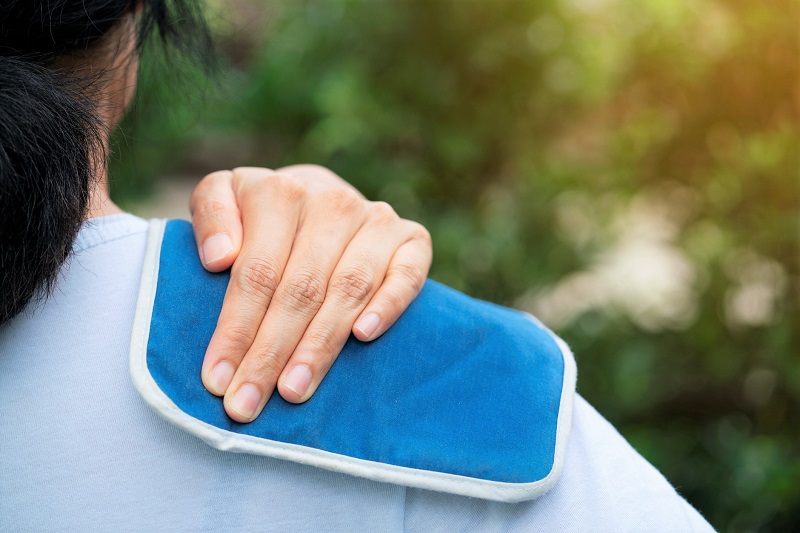30 minutes of daily activity heats up your metabolism and keeps your body burning calories.1 That’s why Nutrisystem recommends regular exercise as an essential part of your weight loss plan. But when you’re just starting a new workout program or when you exert yourself more than usual, you might experience sore muscles—maybe enough to make you want to skip a day or two of activity.
The Cause of Sore Muscles
According to the American Council on Exercise (ACE), there are two kinds of sore muscles that are correlated with physical activity. “Immediate muscle soreness quickly dissipates and is the pain you feel during, or immediately after, exercise. Delayed muscle soreness signals a natural adaptive process that the body initiates following intense exercise.”2
Delayed muscle soreness (DOMS) happens about a day or two after your workout and typically goes away after 72 hours, says ACE. This is a common experience for people who work out, both new and experienced exercisers alike.3
Researchers theorize that DOMS is caused by microscopic tears in the connective tissue around the muscle that happens during “eccentric exercise.” If you are trying a new type of exercise, exercising longer or more often, increasing your intensity or are a beginner just getting started with a workout routine, you may experience DOMS at some point during your fitness journey.4
Please note that there is a difference between common soreness and pain from injury or overuse. The pain you are experiencing should not prevent you from doing everyday activities or last more than 72 hours. You also should not experience pain during or immediately after your workout.5 Sharp or stabbing pains that continue to get worse in the coming days are an indication of injury and should be assessed by a healthcare provider. Speak to your doctor if you have any questions or concerns about sore muscles.
Should You Exercise With Sore Muscles?
So, should you exercise when you have sore muscles? The answer varies. According to the National Kidney Foundation, exercise may actually help the soreness dissipate. “The best way to relieve muscle soreness is to perform some gentle exercises, like walking or light stretching. It may seem counter intuitive, but the more you move, the faster the discomfort will go away!” they explain.5
According to ACE Physical Therapy & Sports Medicine Institute, performing “low-level” workout moves that are similar to the moves that caused the soreness may help DOMS. This enhances blood flow to the muscle while also helping to decrease pressure and fluid.6
“Whether or not you should work through this type of pain is a tricky answer. If you’re only experiencing low-level soreness, . . . it’s probably okay to do a lighter workout. Some physical activity might even help to ease the achiness,” says Cleveland Clinic. “If your DOMS is a bit more painful, it’s best to avoid strenuous exercise until you are no longer sore.”7
The University of Virginia mimics this advice, stating that “whether or not you should work out when you’re sore just depends on how sore you are.” Being a little stiff or sore is OK, but if your pain increases or you’re limping and unable to walk normally, you should decrease your intensity.8
Preventing Sore Muscles

Ready for some good news? Repaired muscles adapt, so they are less prone to the tiny tears the next time you do the same exercise.4
According to ACE, the top method for preventing DOMS is “gradual progression and conservative increases in intensity, frequency and duration.”2
If you’re new to exercise, start with lighter weights. Over time, gradually increase the intensity and frequency of your workouts. If you are an experienced athlete but want to try something new, take extra precaution by also beginning gradually. Doing a warm up exercise before an intense workout may also help, as this increases blood flow and helps prepare muscles for exertion.2
Another, less conventional, method of potentially reducing post-exercise DOMS? Turmeric! The spice that makes mustard yellow, turmeric has been shown to reduce inflammation in our bodies, according to research in the journal Physical Activity and Nutrition. “In conclusion, although there are conflicting results regarding the effect of curcumin supplementation on DOMS, individuals who are new to exercising, resuming exercise, or looking for gradual improvements in their exercise programs may consider curcumin supplementation as a method of nutritional intervention to reduce post-exercise DOMS,” conclude the researchers.9
Turmeric is available as a root you grate yourself or as a powder in the spice section of the grocery store. You can add it to smoothies or try it in our delicious Garlic Ginger Chicken Bites recipe! >
Sore Muscle Relief

“To date, a therapy that consistently relieves delayed muscle soreness has yet to be identified,” says ACE.2 According to the American College of Sports Medicine, you may be able to decrease the symptoms of DOMS with common treatments. However, there is very little evidence that these methods will quicken recovery.10
“If the primary goal is to reduce symptoms, then treatments such as ice pack application, massage, tender-point acupressure, and oral pain relief agents may be useful in easing pain,” they explain. However, “It is important to be aware that pain reduction does not represent recovery. Rather, these treatments may only be effective in reducing symptoms of pain, but underlying muscle damage and reduced function may persist.”10
*The information is not intended or implied to be a substitute for professional medical advice, diagnosis or treatment. Speak to your doctor if you are experiencing sore muscles or pain and before starting a new exercise routine or diet.
Sources:
- https://medlineplus.gov/ency/patientinstructions/000893.htm
- https://www.acefitness.org/education-and-resources/lifestyle/blog/42/what-causes-muscle-soreness-and-how-is-it-best-relieved/
- https://pubmed.ncbi.nlm.nih.gov/12617692/
- https://www.acefitness.org/education-and-resources/lifestyle/blog/6650/don-t-be-a-sore-loser-dealing-with-muscle-soreness/
- https://www.kidney.org/content/understanding-muscle-soreness-%E2%80%93-how-much-too-much
- https://ace-pt.org/exercise-routine/
- https://health.clevelandclinic.org/is-your-exercise-causing-good-or-bad-pain-how-to-tell/
- https://blog.uvahealth.com/2018/01/03/avoiding-post-workout-soreness-rhabdomyolysis/
- https://www.e-pan.org/journal/view.php?doi=10.20463/pan.2020.0020
- https://www.acsm.org/docs/default-source/files-for-resource-library/delayed-onset-muscle-soreness-(doms).pdf
The post Exercising Sore Muscles: Should You Work Out Anyway? appeared first on The Leaf.
from The Leaf https://ift.tt/3jvsC4K
source https://weightlossofrecipes.blogspot.com/2021/06/exercising-sore-muscles-should-you-work.html










0 Comments